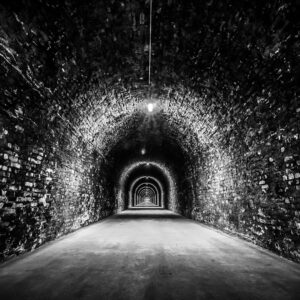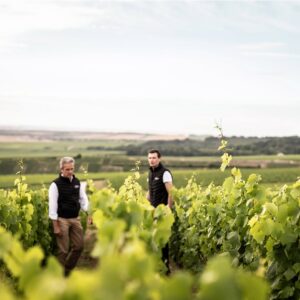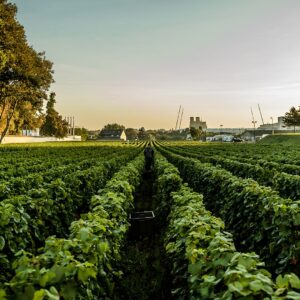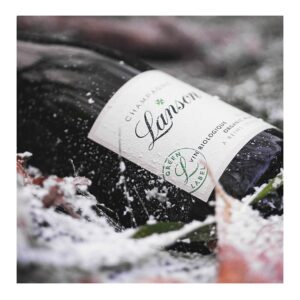Another blast sets a young woman’s nerves on edge as she whispers to herself, “I don’t think I can take much more.” The walls vibrated continuously, bringing anxious thoughts of whether the integrity of the building could hold and each hit triggered the battle she was fighting within herself; was it better to live above ground taking her chances of being bombed? Or was it better to resign herself to live underground with the possibility of being buried alive? During World War I, she was temporarily living in Champagne Lanson’s cellar, deep within the earth, among her family and neighbors in their beloved city of Reims, in the Champagne wine region of France.
Today it is much more common to focus on “the Greatest Generation” during WWII as it was a glorified time in history that shaped the future in ways that are still evident today, but another generation is often times not talked about… the “Lost Generation”.
Champagne Lanson 1760
“Lanson has been through good times and less good times,” noted François van Aal, president of Champagne Lanson 1760, and the main facilities of Lanson, located in the center of town, only a 15-minute walk from the famous Reims Cathedral, found itself housing many of the townspeople of Reims during WWI. Other Champagne houses also provided shelter deep within their cellars during that time, but Lanson’s short distance from the Reims Cathedral, which was specifically targeted during the attacks, made the horrific reality of war that much more real for those living within their cellars.
François said that basic needs such as beds for sleeping and chairs and tables for eating were provided in the Lanson cellars, but makeshift schools and churches were also erected with significant life events such as weddings taking place all underground. And today, many of the descendants of those who survived while living in Lanson’s cellars are grape growers who have had long relationships with the Champagne house, selling their cherished family grapes to them every year.
The winemaker of Champagne Lanson, Hervé Dantan, says that his relationship with the growers is extremely important and that, in general, Champagne winemakers are spending more and more time in the vineyards as at one time they were mainly seen as master blenders that blended a multitude of small plots and back-vintages to make the house style of their non-vintage (NV) Champagne. Blending is still a vital skill and Hervé proudly states that their non-vintage “Black Label” Lanson Champagne is made up of a “minimum of 50% of Grand Cru and Premier Cru vineyards” as well as a significant amount of reserve wines (back vintages of wine preserved in stainless steel vats) such as what is blended into the current market release of the NV Lanson “Black Label” containing 35% of reserve wine that goes as far back as 2006. Blending high proportions of top quality vineyards has always been a key factor to Lanson’s house style that has been recently enhanced by a 20 million Euros investment, over the past 15 years, into their winery and cellaring facilities that allow them to vinify and preserve smaller plots of grapes that Hervé finds to have special qualities, hence bringing more precision to his blending.
Besides selecting high-quality grapes throughout the Champagne region, the two other key qualities to create the Lanson style are a long cellaring period before release and retaining more acidity during their winemaking process that creates “freshness”.
After all the various wines in their individual vats are blended to create the house style that has the qualities of “freshness, fruitiness and elegance”, the wine is placed in bottles to go through the second fermentation that creates the bubbles, and then each bottle ages on its lees (residual yeast left over from fermentation). According to Champagne regulation, each non-vintage Champagne must age in its bottle for at least 15 months before it is released onto the market, but Lanson ages their Black Label in bottle for four years as Hervé notes that giving each bottle of Champagne that significant amount of time will allow it to find an ideal “balance”.
The last part of Lanson’s tenets, retaining an intense vitality and freshness, has been a critical factor in differentiating themselves from most other Champagnes. That freshness is retained by mostly avoiding malolactic fermentation (MLF), which is the process where tart malic acid is converted into softer lactic acid. Only 20% to 25% of their Black Label has gone through the MLF process, but the rest of their wines, such as their vintage Champagnes and single vineyard bottlings, have no MLF allowed on any of the wines that are used for the blend. Although Lanson has had an excellent reputation among those who know the great quality for their reasonable price compared to other Champagnes, Lanson is undoubtedly not on the same level of fame as some of the top Champagne houses on the international market. Some in the past had thought when heavier, creamier Champagne was in vogue, it was not the best marketing choice to retain so much freshness, but Lanson, having a loyal customer base, decided to keep true to their style and today such vitality in a Champagne is appreciated a lot more.
But through the years, a stronger focus on sustainability has become a top mission for Lanson despite Champagne growers thinking it was impossible in the past with bouts of significant rain and intense cold throughout the growing season. Yet Hervé explained that it has become essential for the survival of the land and the environmental quality of life for the local community, and being the son of a Champagne grape grower himself, he has a deep personal investment in protecting his home for future generations.
As of 2018, Lanson now has the “Green Label” sourced from a single vineyard they own in Champagne that is certified organic and certified biodynamic. Lanson owns 125 acres of the over 1,000 acres of vineyards across Champagne that goes into their various bottlings, and their own organic and biodynamic vineyards are becoming an inspiration for the other grape growers. Hervé says that the single vineyard for the “Green Label” is a way for Lanson to find the “future of viticulture” for Champagne, and many of the grape growers that work with him are now becoming certified sustainable through the HEV (High Environmental Value) program in France.
To Know What the Future Holds
As a college-age woman ponders her seemingly bleak and hopeless world, she walks past the handsome red brick house of Lanson that first welcomes guests into their tasting room in Reims. The woman stops and takes a deep breath as she thinks about her great-great-grandmother, who was around the same age when she took shelter in the Lanson cellars during World War I. The woman had recently been given journals that contained drawings from her great-great-grandmother during and after that time; during two world wars, during the pandemic of 1918, during the Great Depression and during a rapidly changing world. At first, the drawings were hopeful and beautiful with only a few dark and disturbing images throughout, yet the last couple of journals became more disturbing with their imagery that hinted towards her great-great-grandmother being overwhelmed by desperation as she became part of the generation known as the “Lost Generation” – a generation that was disillusioned by all the death and carnage they witnessed as well as eventually feeling lost in a quickly evolving modern world.
The young woman felt a deep connection with her great-great-grandmother through those drawings, and she felt as if she was part of another lost generation herself, living during a pandemic that put all future opportunities in limbo, and the uncertainly of a world with clean air and clean water for all weighed on her every night. Through time she wanted to know if her great-great-grandmother eventually became optimistic again… she went through her parents’ basement and closets looking for other journals that would suggest a happy ending. But the young woman’s mother was insistent that she already had the last journals, with the darkest and most bleak drawings, and that it would have to be assumed that there was only despair at the end.
As the young woman wiped away the tears starting to stream down her face, she took comfort in the fact that her grandmother, let alone her great-great-grandmother, could never imagine a world where so much attention was given to the grape growers of Champagne to the point where the son of a grape grower would end up being the head winemaker, a.k.a. chef de caves, and that they would have a granddaughter who, herself, could consider going down the path of becoming a winemaker. As she opened the door to the Lanson tasting room, she saw the “Green Label”, the Champagne she was most eager to try, a wave of hope warmed her heart with the idea that her generation would not be lost as they know the values they want to see in the world, and the world is responding.
***This article first appeared on Forbes: https://www.forbes.com/sites/cathrinetodd/2022/02/11/champagne-house-that-saved-a-town-during-wwi-is-now-saving-environment/

NV Lanson “Black Label” Brut Champagne: 50% Pinot Noir, 35% Chardonnay and 15% Pinot Meunier from around 100 vineyards in Champagne made up of 50% Grand Cru and Premier Cru vineyards. Stony minerality at the core of this lovely Champagne with aromatic notes of lime blossom and spice that had a toasted almond note on the elegantly expressive finish.
NV Lanson “Green Label” Brut Champagne: 50% Pinot Noir, 20% Chardonnay and 30% Pinot Meunier from grapes that are certified organic and certified biodynamic, and ages on the lees for four years. Beautiful pristine pear and nectarine fruit with hints of honeycomb and an enchanting floral quality on the finish.
2009 Lanson Vintage Brut Champagne: 52% Pinot Noir and 48% Chardonnay made solely from Grand Cru and Premier Cru vineyards. A warm vintage that expressed delicious notes of candied orange peel and pastries with an underlying note of chalky minerality.
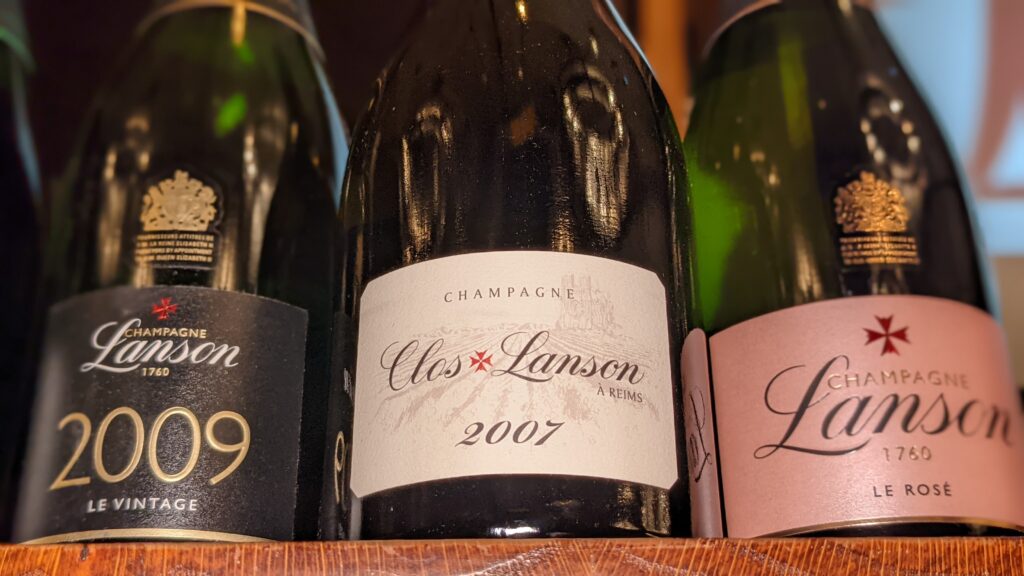
2007 Lanson “Clos Lanson” Brut Champagne: 100% Chardonnay made exclusively from biodynamic grapes from the “Clos Lanson” plot. Lemon drops with peach pie and dried violet notes that had a creamy texture with fierce acidity, intense drive and focus.
NV Lanson Rosé Brut Champagne: 53% Pinot Noir, 32% Chardonnay and 15% Pinot Meunier from around 100 vineyards in Champagne made up of 50% Grand Cru and Premier Cru, and aged four years on the lees. Light pink color with fresh raspberry and strawberry flavors that had a floral hint with more weight mid-palate on the body than other Champagnes yet plenty of bright acidity.

